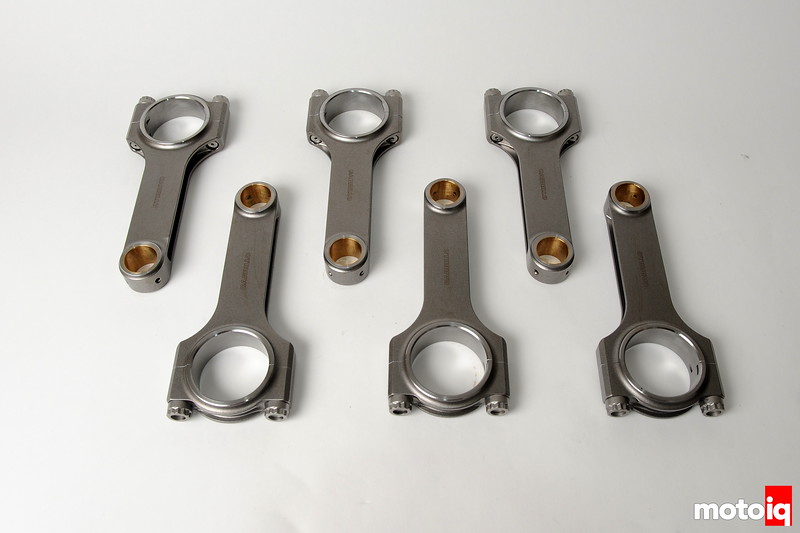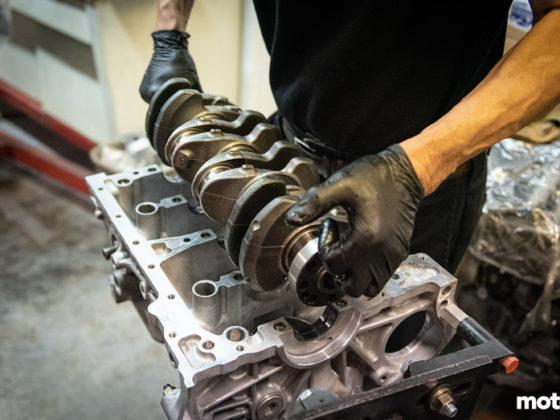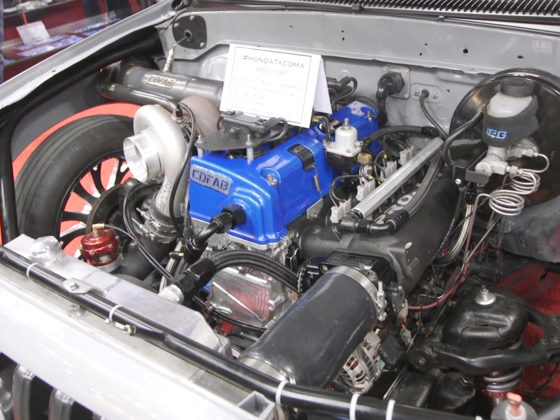
The R35 GT-R is an exceedingly capable car. With tons of support from the aftermarket and a basically strong platform, it is capable of world-class performance. The VR38DETT is an exceptionally strong engine. In stock form, it can withstand over 600 whp in mods. The trouble is the bolt-on mods available for the GT-R even with stock turbos can exceed 700 whp and in this case, the VR38DETT tends to break connecting rods. Good tuners will purposely reduce the torque and manage power lower but when the stock engine is on the edge of whats safe, something like a tank of bad gas can ruin your day.
This is exactly what happened in this car. This R35 had a full complement of high-quality bolt-on parts that had been carefully tuned. The owner of the car drove it daily and drove it hard. This was fine for many years but one day one of the stock Nissan rods let loose and with a kaboom, took out the block and oil pan as well. It was time for a new engine. The owner did not feel that he needed more power but he did want something that would be bulletproof at his current levels of mods. Since this is something that all maxed out bolt-on GT-R owners face and should be a pretty common level of build. We are going to be replacing the weak parts with goodies from Carillo and CP Pistons!

Since the rods are the Achilles heel of the VR38DETT and it is such an expensive engine to blow up, we decided to source what we feel is one of the best connecting rods made- period. We obtained a set of Pro-H beams from Carrillo. We usually prefer H-Beam rods because the shape lends itself to higher resistance to lateral-torsional buckling, which is the primary mode of failure for most beam structures under compression. The H gives the most resistance in a rod’s natural stressed direction with the least amount of material. The H Beam is a more expensive design because the forging is now a multi-step process which is why it is not used for OEM applications for the most part.
Carrillo rods are heat-treated using a maraging process, resulting in an ultimate tensile strength of 195,000 psi with a yield point of 182,000 psi. Maraging means that the alloy used is a maraging steel alloy. These alloys are known for strength without the brittleness associated with many strong and hard steel alloys. A Maraging alloy is precipitation heat treated to convert most of the austenite (a less strong form of steel) to martensite (a stronger form that the heat treating distributes through the steel’s crystal structure).

All Carrillo connecting rods are CNC-machined from an oversized blank forging resulting in the proper grain flow and are surface machined to ensure the removal of any potential inclusions or surface conversions such as scale generated by the forging process. These inclusions can cause stress risers that reduce cyclic fatigue strength. The rods’ caps’ mating surfaces have a unique sawed surface to reduce the shear load on the rod bolts that are experienced due to the offset angle of the cap. The main caps have an outer “cheeked” contour that gives strength to the rod cap under side loads as well. The small end of the rod has oil reservoir countersink on the top of the rod’s small end. This helps the small end of the rod get better lubrication. The rod’s small end bushing is aluminum silicon bronze with a very smooth surface finish of 4RA in addition to lapped sides and a radius on the outer shoulder to be easier on the wrist pin.
A final multi-stage shotpeen operation completes the rod. Shotpeening greatly improves fatigue strength by forming a tough fine-grained surface skin on the part. Carrillo Rods are fully machined, Magnaflux inspected and balanced as a set to +/- 1 gram before being shipped to the customer.
With any rod, the bolts are the most highly stressed and critical part. Carrillo Pro-H rods come with CARR fasteners. The CARR fasteners are made from multi-phase TM material, giving them a higher Ultimate Tensile Strength (UTS). Carrillo rod bolts are a proprietary design with asymmetrical threads that have more engagement on the thrust side for better strength and more accurate torque readings. The base bolts are made of super-strong H11 tool steel. H11 is a steel alloy with high amounts of chromium that exhibits a high degree of tensile strength and toughness. The H11 bolts have an impressive ultimate tensile strength of 220,000 PSI.

With our connecting rod blues solved it was time to address another VR weak spot, the pistons. We turned to CP for a set of their forged pistons designed specifically for the VR38DETT. Our CP pistons are forged from tough low silicon 2618 alloy. 2618 is a tougher alloy than high silicon alloys like 4032. The main disadvantage to 2618 is that it expands more with heat so it needs to run a bigger piston to wall clearance. This can result in noise, piston slap, and greater wear. CP has largely made this a moot point with their advanced piston skirt cam profiles which allow tighter clearances and reduce noise and slap.




10 comments
i had always heard that Nissan engines, particularly the RBs, were underpowered in comparison to how robust they were. Those days, apparently, are long gone when we get 500+ HP out of bolt-on upgrades.
Any downsides to the narrow rod bearings?
Less surface area to maintain the oil film so less pressure needed before getting bearing wear. Good oil flow and pressure can somewhat mitigate it.
Very nice article, really accessible, will there be updates?
Also, I couldn’t help wonder, was there any discussion about the downpipes getting coated? Did any other goodies get thrown in “since you were in there anyway?”
Been a reader since SCC and still miss that magazine!
Other than the PC9 coating on the pistons, the parts were kept mostly stock. This was a customer car and they just wanted their car back. Though it may not seem like a lot was done, the total gets up there pretty quick thanks to the GT-R tax.
Great write up guys. Just to add some context:
The original motor was stock with about 90k mi on it, most of which was spent with the boost up for WOT on E85. It was not in fact bad gas that lead to failure but rather an accidental downshift at WOT which resulted in a low RPM load on the OEM rods. If that had not happened, my guess is the engine would still be alive. That tune had a reduction in torque as mentioned in the article. But even with the motor build, that mistake should not be repeated. if you have a GTR – don’t let that happen!
The owner just dynod the new setup and the results were impressive with the stock turbos. The head work appears to have netted a consistent gain in TQ across the rev range; but more impressively the peak TQ RMP was lowered by over 700 RPM’s down to 3,500 RPM’s.
Great build guys. Hi Howard, Mike and Martin.
I’ve really loved all of these modification articles / videos on the project GT-R. I was wondering if you would be making a video comparing the modified car’s performance to a stock car? Maybe quarter mile, 0-62, and a few laps on a track or Auto-X?
I think it would be really great to have some sort of benchmarking so that owners will know how the mods improve the car in more sure terms.
Thanks,
The car came here with a windowed block so no before!
could you be so kind to share you piston to wall clearance along with main and rod bearing clearance. this seems to be a very secretive issue when it comes to building a vr38 motor for about 1200hp or so.
We don’t give that information away either. Its part of our engine building service.